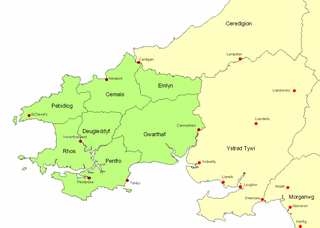
Deheubarth was a regional name for the realms of south Wales, particularly as opposed to Gwynedd. It is now used as a shorthand for the various realms united under the House of Dinefwr, but that Deheubarth itself was not considered a proper kingdom on the model of Gwynedd, Powys, or Dyfed is shown by its rendering in Latin as dextralis pars or as Britonnes dexterales and not as a named land. In the oldest British writers, Deheubarth was used for all of modern Wales to distinguish it from Hen Ogledd, the northern lands whence Cunedda originated.

The Kingdom of Powys was a Welsh successor state, petty kingdom and principality that emerged during the Middle Ages following the end of Roman rule in Britain. It very roughly covered the northern two-thirds of the modern county of Powys and part of today's English West Midlands. More precisely, and based on the Romano-British tribal lands of the Ordovices in the west and the Cornovii in the east, its boundaries originally extended from the Cambrian Mountains in the west to include the modern West Midlands region of England in the east. The fertile river valleys of the Severn and Tern are found here, and this region is referred to in later Welsh literature as "the Paradise of Powys".

Seisyllwg was a petty kingdom of medieval Wales. It is unclear when it emerged as a distinct unit, but according to later sources it consisted of the former Kingdom of Ceredigion plus the region known as Ystrad Tywi. Thus it covered the modern county of Ceredigion, part of Carmarthenshire, and the Gower Peninsula. It is evidently named after Seisyll, king of Ceredigion in the 7th or early 8th century, but it is unknown if he was directly responsible for its establishment. In the 10th century Seisyllwg became the centre of power for Hywel Dda, who came to rule most of Wales. In 920 Hywel merged Seisyllwg with the Kingdom of Dyfed to form the new kingdom of Deheubarth.
Idwal Foel or Idwal ab Anarawd was a 10th-century King of Gwynedd in Wales. A member of the House of Aberffraw, he inherited the throne from his father, Anarawd ap Rhodri. William of Malmesbury credited him as "King of the Britons" in the manner of his father.
Idwal ab Idwal, usually known as Ieuaf to distinguish him from his father Idwal Foel, was joint king of Gwynedd in northern Wales from 950 to 969. He possibly also ruled Powys for some time.
Hywel ap Ieuaf was a King of Gwynedd in north-west Wales from 979 to 985.
Owain ap Hywel was king of Deheubarth in south Wales and probably also controlled Powys.

Cadell ap Rhodri (854–909) was King of Seisyllwg, a minor kingdom in southwestern Wales, from about 872 until his death.
Llywarch ap Hyfaidd was a king of Dyfed from c. 893 until its conquest around 904 by King Cadell of Ceredigion / Seisyllwg and his son Hywel.
Rhodri ap Hyfaidd was briefly the king of Dyfed in southwestern Wales. After his brother Llywarch was killed by Hywel Dda and his father Cadell, Rhodri briefly reigned before he himself was killed and the throne was usurped by Hywel, under whom the kingdom then merged with Seisyllwg to form Deheubarth.

The Kingdom of Dyfed, one of several Welsh petty kingdoms that emerged in 5th-century sub-Roman Britain in southwest Wales, was based on the former territory of the Demetae. The medieval Irish narrative, The Expulsion of the Déisi, attributing the kingdom's founding to Eochaid, son of Artchorp, being forced across the Irish sea, in the 5th century; his descendants founding the line of the kings of Dyfed, down to "Tualodor mac Rígin". The Normans invaded Wales, and by 1138 incorporated Dyfed into a new shire called Pembrokeshire after the Norman castle built in the Cantref of Penfro and under the rule of the Marcher Earl of Pembroke.

Ystrad Tywi is a region of southwest Wales situated on both banks of the River Towy, it contained places such as Cedweli, Carnwyllion, Loughor, Llandeilo, and Gwyr. Although Ystrad Tywi was never a kingdom itself, it was historically a valuable territory and was fought over by the various kings of Dyfed, Deheubarth, Seisyllwg, Gwynedd, Morgannwg and the Normans.

The Royal House of Dinefwr was a cadet branch of the Royal House of Gwynedd, founded by King Cadell ap Rhodri, son of Rhodri the Great. Their ancestor, Cunedda Wledig, born in late Roman Britain, was a Sub-Roman warlord who founded the Kingdom of Gwynedd during the 5th century, following the Anglo-Saxon settlement of Britain. As Celtic Britons, the House of Dinefwr was ruling before the Norman conquest, having to fight with their neighbors such as the Celtics, Anglo-Saxons and Vikings, before struggling with the Normans afterwards. Many members of this family were influential in Welsh history, such as Hywel Dda, who codified Welsh law under his rule, and achieved the important title of King of the Britons, or Lord Rhys, Prince of Wales, who rebelled against Richard the Lionheart, and became one of the most powerful Welsh leaders of the Middle Ages.
Edwin ap Hywel was a 10th-century king of Deheubarth in Wales of the High Middle Ages.
Rhodri ap Hywel was a King of Deheubarth in South Wales, and son of Hywel Dda.
This article is about the particular significance of the century 901–1000 to Wales and its people.
Gwgon ap Meurig was a 9th-century king of Ceredigion and Ystrad Tywi in southwest Wales.
Hyfaidd ap Bleddri was a king of Dyfed.









